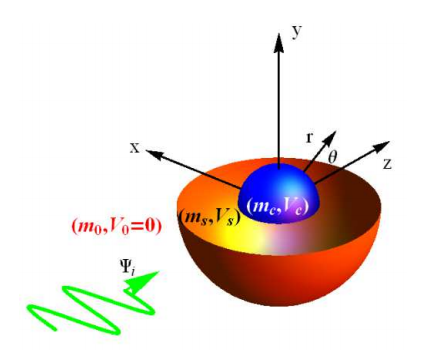Quantum Invisibility Cloak Hides Objects from Reality
Invisibility cloaks are all the rage these days. Over the last few years, this blog has followed various attempts to develop invisibility cloaks for earthquakes, acoustics and for various parts of the electromagnetic spectrum. In the last few days, we’ve seen the emergence of a new generation of cloaks that can hide large, everyday objects across the entire optical spectrum.

Today, Jeng Yi Lee and Ray-Kuang Lee at the National Tsing-Hua University in Taiwan take the idea of cloaking to its ultimate limit. These guys have worked out how to build quantum invisibility cloaks. These are cloaks that shield objects from the quantum properties of the world outside. That’s not so much an invisibility cloak as a reality cloak.
The idea is simple in essence. Ordinary invisibility cloaks work by steering light around a region of space to make it look as if it weren’t there. The mathematical approach that describes this is called transformation optics. It starts with Maxwell’s equation which govern the behaviour of light as it passes through space.
One way to think of light is as a field in space. In transformation optics, this field can be stretched and squeezed like a rubber sheet when it passes through certain types of material. The goal is to engineer this material so that it stretches the sheet around regions of space and so make them invisible.
The approach developed by Jeng Yi and Ray-Kuang is mathematically identical to this. But instead of starting with Maxwell’s equations, they start with the Schrodinger equation which governs the probability of an object being present in a region of space.
Their idea is to treat this probability field like a rubber sheet that can be stretched and squeezed. So the goal in designing a quantum invisibility cloak is to stretch this sheet around a region of space so that the probability of existing inside it is zero. In effect, they’re designing a cloak that shields its contents from reality.
There are several important caveats here. The first is that the shield would be designed to shield from a particular form of Schrodinger equation, perhaps associated with electrons for example. That would shield a region of space from the quantum properties of nearby electrons but not necessarily from other things.
So such a cloak would provide shielding from certain aspects of reality rather than all of it. Making a “broadband” reality cloak that hides from many quantum objects at once would presumably be a much bigger challenge, if it is possible at all.
Another important point is that this paper is entirely theoretical. Jeng Yi and Ray-Kuang provide a theoretical treatment of a nanoshell that cloaks the region of space within it from the effects of matter nearby. This approach demonstrates that the idea is possible on the nanoscale, at least in principle.
The big challenge of course will be to find ways of implementing the technique for real. That will take some impressive engineering but Jeng Yi and Ray-Kuang say it ought to be possible using today’s semiconductor technologies.
So the idea would be to create a hollow nanoparticle, perhaps out of silicon, that would shield its contents from electrons passing nearby. That’s something that could be useful for quantum information storage or processing, for instance.
That’s an interesting idea that could stimulate an entirely new approach to shielding. If it sounds a little far-fetched, it’s worth bearing in mind the timescale over which conventional invisibility cloaks have emerged. The original theoretical paper proposing the idea appeared on 25 May 2003 and the paper describing the first working cloak appeared on 19 October the same year.
If the development of quantum invisibility cloaks is anything like that, we could see one in operation before the end of the year.
Ref: arxiv.org/abs/1306.2120: Hide The Interior Region Of Core-Shell Nanoparticles With Quantum Invisible Cloaks
Deep Dive
Computing
How ASML took over the chipmaking chessboard
MIT Technology Review sat down with outgoing CTO Martin van den Brink to talk about the company’s rise to dominance and the life and death of Moore’s Law.
How Wi-Fi sensing became usable tech
After a decade of obscurity, the technology is being used to track people’s movements.
Why it’s so hard for China’s chip industry to become self-sufficient
Chip companies from the US and China are developing new materials to reduce reliance on a Japanese monopoly. It won’t be easy.
Stay connected
Get the latest updates from
MIT Technology Review
Discover special offers, top stories, upcoming events, and more.